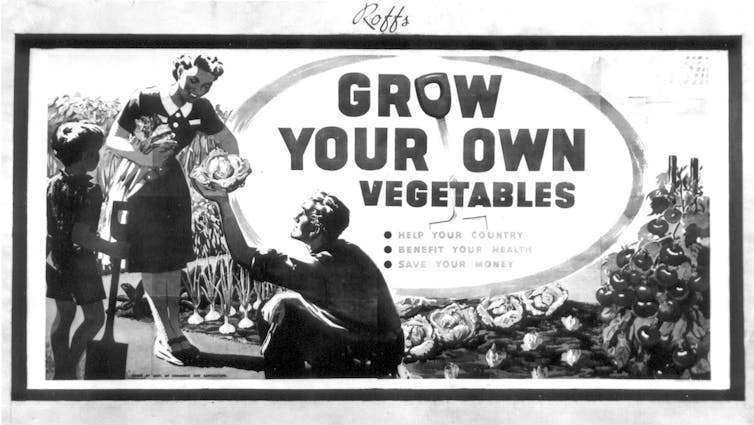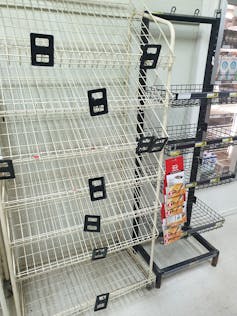We've had a taste of disrupted food supplies – here are 5 ways we can avoid a repeat
- Written by Kimberley Reis, Lecturer, School of Environment and Science, Griffith University, Griffith University
When our reliance on supermarkets is seriously disrupted – for example, by spikes in demand due to panic buying or the flooding of distribution centres – we are left with few alternatives. Supermarkets are central to our everyday lives, but they have also become symbols of our vulnerability in times of disruption.
The COVID-19 crisis has caused us to rethink many things we took for granted. This includes the plentiful supply of a great variety of food at relatively stable prices in our supermarkets.
Read more: Grow your own: making Australian cities more food-secure
Until recently, if we thought about food security at all, it was more likely to conjure images of malnutrition in countries of the global south rather than empty supermarket shelves.
However, food insecurity exists in Australia. It can be experienced as hunger and also as feelings of anxiety about future food shortages.
The rise of supermarkets and global supply chains
Supermarkets were a 1930s success story that began during the Great Depression. The world’s first supermarket, King Kullen, opened with the enduring principle of “Pile it high, sell it low!” King Kullen became the standard model of supermarket operations with globally interconnected supply chains.
While this model epitomised the trend of globalisation, during the second world war more local food production was encouraged in the form of “victory gardens”. These made a significant contribution to food security during the war years. It was a demonstration of what can be achieved in times of crisis.
 An Australian government ‘Grow your own’ campaign billboard from 1943.
NAA C2829/2
An Australian government ‘Grow your own’ campaign billboard from 1943.
NAA C2829/2
Read more: Is it time to resurrect the wartime 'Grow Your Own' campaign?
‘What if’ questions help us build resilience
Contingency planning is about being clear on your Plan B or Plan C if Plan A hits trouble. It’s about asking the “what if” questions. As a planning tool, this enables systems to build resilience to disruption by identifying other pathways to achieve desired outcomes.
The difference between now and the 1930s is that today we are vastly more connected at a global scale. Within our food-supply chains, we can use the knowledge that comes from this greater connectivity to ask different “what if” questions.
 Even before the coronavirus pandemic hit, some stores in bushfire-affected communities ran out of basic food supplies.
Steve Jackovljevic/AAP
Even before the coronavirus pandemic hit, some stores in bushfire-affected communities ran out of basic food supplies.
Steve Jackovljevic/AAP
For example, what if a pandemic and a severe weather event overlapped, disrupting critical transport infrastructure? How could we adapt?
Or what if several Australian states experienced serious disruptions to food supply at the same time? How could we ensure timely resupply?
Recent experiences of empty supermarket shelves remind us of the importance of such questions.
Greater self-sufficiency is sensible and practical. Australia’s National Strategy for Disaster Resilience makes clear that we should understand the risks we live with – in this case, our deep-seated and often unquestioned dependency on long food-supply chains.
Read more: To protect fresh food supplies, here are the key steps to secure city foodbowls
The strategy also calls for authorities to help empower citizens to share responsibility where they can in building their own resilience to hardship. This taps into a primal urge, as we have seen in the recent spike in demand for seedlings and vegetable plants at nurseries as people take to home gardening, digging not so much for victory as for survival during a shutdown.
Strategies to prepare for the next crisis
These questions highlight the need to think about ways to complement and enhance existing arrangements for supplying food. Our research identifies several immediate opportunities to promote shorter food-supply chains and devise contingency food plans:
1. We can buy more locally produced food staples, support local producers at a farmers’ market, join a Community Supported Agriculture (CSA) group, or take advantage of online platforms that make a range of locally grown food more readily available.
2. Local businesses can embed contingency arrangements to ensure access to locally produced food within their business continuity plans, building greater capacity to keep business and local economies operating in difficult times.
3. Supermarkets can advocate for and support shorter food-supply chains by sourcing food products locally where possible and championing “buy local” campaigns.
4. An active undertaking to identify and map the regional food bowls of each city and township will support contingency plans.
5. Local councils can help make it possible to grow much more of the food we need, even in relatively dense towns and cities. This can range from potted herbs on apartment balconies, through to broccoli in suburban backyards to intensive farming operations in big industrial estate sheds or rooftops. Municipal parks that feature little more than lawn can devote some space to community gardens, while more rigorous land-use planning regimes can protect market gardening near urban centres.
Read more: Farming the suburbs – why can’t we grow food wherever we want?
Societies have faced significant food and health crises over the centuries. Now, though, we have almost real-time data on food production, stocks and supply chains. Would it not be sensible to strengthen local food systems that can complement our supermarkets and global networks?
If we don’t do this, the only lesson we will have learned from the coronavirus crisis is to start hoarding baked beans, toilet paper and hand sanitiser as soon as we first hear of a looming disaster.
Authors: Kimberley Reis, Lecturer, School of Environment and Science, Griffith University, Griffith University



